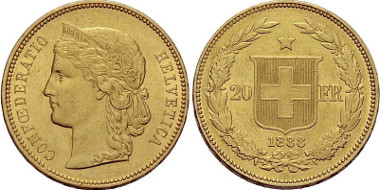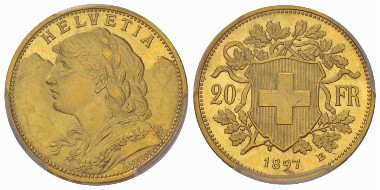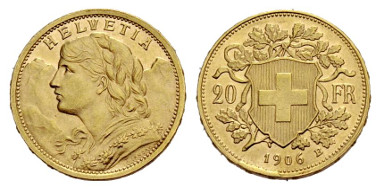translated by Christina Schlögl
Between the years of 1897 and 1949, the Swissmint minted 58.6 million Vrenelis in total. No wonder there are still plenty of them left and many banks sell them for the gold price with a small surcharge.
The 20-francs coin was minted with the regulations of the Latin Monetary Union and could circulate in all member states. It only came to its end as a circulation coin in 1936. Forced by measures of other members of the Latin Monetary Union, the Swiss Federal Council adjusted the Swiss currency to international standards and devalued the franc at around 30%. The value of a Swiss Franc was defined to be between 190 and 215 mg of refined gold, as opposed to the former value of 290 mg. Thus the gold value of the 20-francs coin rose to 28 francs. As a consequence it was withdrawn from circulation without officially being made invalid. Nevertheless nearly 20 more millions were struck in 1945, 1946 and 1947.
20 francs 1888. From the auction Sincona 1 (2011), 2069.
The difficult birth of the Vreneli
In 1895, the Federal Department of Finance organised a competition in order to find a new design for the 20-francs coins. The current one seemed outdated to them. The commission made their expectations abundantly clear: “The new effigy should make Helvetia accessible to a broad Swiss audience by relying on a Swiss national motif, an allegorical or historical-symbolic representation of her” (in translation).
This is how the artist Fritz Landry saw the modern Helvetia. Image from a brochure of the Swissmint. The Goldvreneli.
They were therefore looking for an image that would not be interchangeable with all former allegories, but that would show Switzerland-specific characteristics. Unfortunately none of the submitted models met the expectations of the Federal Department of Finance. No first prize was awarded. Fritz Landry thus only won the second prize, although the gentlemen of the commission deemed his Helvetia-head too young, too individual and too dreamy. The artist would have to revise this draft to make her look somewhat more maternal and then maybe one could come to terms with this Helvetia.
Landry did as he was told and presented a new draft as early as autumn 1895. However the commission still was not happy with it. The painter Anker, who was called in as a consultant, even described the woman in the draft as a kind of “St. Cecilia”, a “figure pastorale”. But famous numismatist Imhoof-Blumer, who was also asked to give his opinion, could assert himself: “The draft leaves banality and well-trodden paths behind. It finally shows something different than the ordinary antique heads, who have been used to depict our republic in the past” (in translation).
Officials deemed the stray curl on the young lady’s forehead from the first test-mint of the new 20-francs coins too frivolous. From the auction Sincona 14 (2013), 3560 – One of these “Stirnlockenvrenelis” can easily go for more than 100,000 francs!
The “Stirnlockenvreneli”
And so the first test-mints were made and sent to the magistracy in charge of approving the commencement of the minting process. However they promptly rejected them. The curl on Helvetia’s forehead gave “the wench a frivolous look”. And this was certainly inconsistent with the dignity of a personification of Switzerland.
And finally the Vreneli. From the auction Sincona 13 (2013), 2924.
Finally a Vreneli!
Thus the curl was left out and the first coins were minted, put into circulation and caused a great discussion. Some people thought, Switzerland could not be compared to a young maiden but should instead resemble a beautiful woman and mother. Others were opposed to the mountains in the background, since – as a modern industrial nation – one should finally emancipate oneself from the old mountain- and shepherd-people prejudice. Still others would have liked to see William Tell on the effigy.
What was highly controversial at the time, has become one of the most popular gold coins that is still given as a present on traditional occasions like birth or confirmation.
How did the 20 francs become the Vreneli?
It is safe to say that those who paid with the 20-francs coin on a daily basis did not use the term “Vreneli” yet. It was first printed in 1943, which is why we assume that “Vreneli” started being used in Swiss colloquial language towards the end of World War II. Incidentally, Vreneli is a diminutive form of Verena. Even today, Verena is still a very popular name in Switzerland.
The mints after the war
Starting in 1945, a certain part of the Swiss National Bank’s gold holdings were minted into “Vrenelis”. Where did these abundant gold holdings come from? The Allies had their own assumptions: They supposed that the Swiss banks had seized the gold holdings from the German Reich which did not have a legal owner after their defeat in World War II, and sold it to the Swiss National Bank.
The coins that were minted from this gold were solely meant as bullion coins. It did not seem expedient to add the current year for several reasons. Instead they picked the year 1935, to indicate that the coins met the weight- and fineness standards of the gold coins minted until 1935. For the purpose of distinguishing the newly minted coins from the actual mints from 1935, they decided to put an L for lingot (= ingot) before the year.
After the Washington agreement of 1946 on German assets in Switzerland, in which Switzerland – without admitting to any legal ground – committed itself to paying 250 million francs compensation for the retained gold holdings of the German Reich, the correct year was added to the “Vrenelis” and the edge inscription was changed. At the end of 1949, the popular coin was finally discontinued.
However they can still be bought at the daily rate at most Swiss banks.
Numismatic Data of the Vreneli
Coin description:
Obverse: HELVETIA Female bust with a tied up braid to the left, her dress embroidered with edelweiss, a mountain range in the background. In the arm section: signature or the designer F. LANDRY.
Reverse: 20 – FR Swiss coat of arms on escutcheon, beneath: year and B for the mint Bern, in the Background: twigs with oak leaves.
Francs 20 / 900 / 6.452 g (5.8068 g) / 21 mm / 1.25 mm
Here you can find a comprehensive documentation of the genesis of the Vreneli unfortunately only in German.
All episodes of the bullion coins series are available here.







